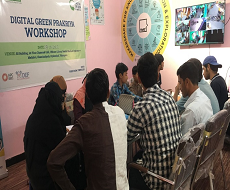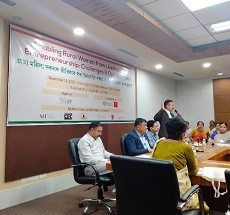

DEF marks 20 years of successful journey in the strive to realise digital inclusion. The central aspect in this journey has been the well designed hubs located in the villages across India which have served more purposes than the ones intended. Each hub continues to be a thriving space even today with a constant flow of visitors of all age groups seeking help, guidance, access and empowerment. The foundation of DEF was laid on the primary objective to provide ‘access’ through digital means. Starting from the Community Information Resource Centre (CIRC) model... Read More


Access to digital technology in India is largely dependent on a person's gender, caste, religion and economic status, Oxfam's 'India Inequality Report 2022: Digital Divide' has found with its reach limited to mostly male, urban, upper caste and upper-class households and individuals. India has a 30% gender gap between men and women when it comes to owning mobile phones. Meanwhile, 94% of the respondents with a phone were salaried permanent workers while "less than 50% of unemployed are with a phone". Read More


Many would struggle to picture a woman when they hear an ‘engineer’, let alone meet one in the villages of India. At DEF, it has become a norm to consider gender bias as an opportunity to transform not just the lives of the women from the community but also the entire rural population that's connected with them. In most programs DEF ensures that the women take up the centre stage which has proved to be effective and perpetuating in terms of improving the lives of people from marginalised communities. Time and again women have powered through challenging situations and attended to their responsibilities using the multi-tasking skills. Read More
The centre Co-ordinator of the CIRC centre in Ziro village shares her experience in understanding the problems of her community through constant engagement and the efforts of her team in getting connected to the digital world through Community Networks. “This would like to narrate my journey from being a resident of the Ziro Valley to a source of bringing something concrete in the valley for my people. The opportunity given to me by Digital Empowerment Foundation, was a game changer for my professional life. In April 2022, we started the baseline survey in the Ziro valley, Arunachal Pradesh. The survey investigated the need and expectations of the people regarding digital literacy, education, governance schemes and entitlements etc. Read More

Soochna Adhikar Kendra is an initiative that helps women from rural India to learn how to operate laptops and smartphones. This program is intended to empower women to use digital devices for their basic needs, irrespective of their background in literacy. Pragati Kumari is a beneficiary of this initiative from Pusa village of Samastipur district. “Recently, through a common friend, I got to know about the Soochna Adhikar Kendra being set up in my neighbourhood. My friend also told me about the services the centre provides and suggested that I have a look and enrol myself. So on my friend’s suggestion, I decided to pay a visit to the centre and learn more about the services they were providing to the community. Read More
Digital Excellence Centres are designed to serve various purposes, mainly centred around providing digital skills to people from all age groups and genders. The IT classes held at the centre provide training on softwares like MS office, under STEM Make2 initiative students are introduced to to hands on learning by tapping into their innovative thinking, Digital Green Prakriya Centre creates awareness about reuse and repair of electronic gadgets and the SoochnaPreneur centre provides the required information on central and state government welfare schemes. The Digital Excellence Centre in Chanchalguda, Hyderabad also houses TASK (Telangana Academy for Skill and Knowledge) where coaching to attend competitive exams, soft skills training and job-oriented skills are imparted. The centres have helped people like Fiza Ghouse who is a 22 year old B.Com graduate. Read More

Smartpur hub and spoke centres are points where people from different age groups avail services and find solutions to their problems. The different beneficiaries of Bharatpur hub and spokes narrate their enriching experience as to how the centre has been a point of troubleshooting for them. Balviro Kaur narrates, “My husband’s name is Om Prakash and I am a resident of Bhojpur village. The past few months have been very difficult for us, since we are farmers and we are dependent on the ‘Pradhan Mantri Kisan Yojana’ instalment each month. For the past few months, I was unable to receive the instalment. I visited the Smartpur spoke centre, Anees (SoochnaPreneur) helped me with all the investigation and told me that I had not done KYC and therefore my instalment was not coming into the account. Read More
Community Information Resource Centres (CIRCs) set up by DEF where most projects are based out of have served people from various categories. Capacity building has been an integral part of the programs curated by DEF which help in effective implementation and scaling up the services that can be extended to the targeted sections of the society. A 9 days capacity building workshop was organised by DEF where trainers from Kisan Trust took up training. The workshop started on 4th November and ended on 12th November which was extended to three trainers from Chhaprauli of Uttar Pradesh. The main objective of the training was to introduce all the training modules under CIRC such as SoochnaPreneur, MakerSpace, Digital Literacy and building critical thinking as well as problem solving skills. Read More

A joint consultation of stakeholders and RWE’s (Rural Women Entrepreneurs) was organised on 16th Nov, 2022 at NEDFI House by Digital Empowerment Foundation (DEF), a pan India ICT for development agency and a core coalition partner member of the BBC programme, co-organised by the Council for Social and Digital Development (CSDD), which witnessed the presence and participation of eminent stakeholders from various fields, working on or related to the RWE sphere like NEDFI, KVIC, NERAMAC, AIDC, AGVB, NSIC, SIDBI, NABARD, Food Safety GOA, APART/ARIAS , IIE etc to name a few. There were representatives from grassroot organisations like CML Tata Trusts, SeSTA, Diya Foundation, Dhritti, SELCO, NEWA and also academia which included TISS and AIM. Read More

The Internet Governance Forum is a "global multistakeholder platform that facilitates the discussion of public policy issues pertaining to the Internet." The Annual meeting was born out of the 2005 Tunis Agenda in the World Summit of Information Societies - asking the UN secretary-general to convene an annual meeting for multi-stakeholder discussion on Internet Governance. The following paragraph is from the IGF's website on the mandates of the Tunis Agenda: Discuss public policy issues related to key elements of Internet governance in order to foster the sustainability, robustness, security, stability and development of the Internet; Facilitate discourse between bodies dealing with different cross-cutting international public policies regarding the Internet and discuss issues that do not fall within the scope of any existing body; Read More
Homelessness is a worldwide problem and government agencies and civil society organisations have come up with various initiatives to suppress the problem. However, none of the initiatives have been completely successful. Many cities across the world are plagued with homelessness, hunger, joblessness and drug addiction. In India there are 1.77 million recorded homeless people according to the 2011 census and real numbers are expected to be much higher. Several organisations have been working for the rights and welfare of the homeless. Some of their interventions have focussed on tracing the families of the clients housed at custodial institutions and then facilitating their reintegration with their families. Read More




As we celebrate 20 years here is a glimpse of our journey and a few milestones we crossed along the way.

Riya* (45), a beautician with Urban Company, a home services business that operates in major cities in India, is talking about the time a client withheld payment of Rs 1,500 for her services. The problem arose at the end of the session when it turned out that the client did not have cash at home and Riya had not set up a payment app on her phone. "I had no option but to come back for the money 10 days later," Riya told IndiaSpend. For the report, Oxfam analysed data from the Centre for Monitoring Indian Economy's (CMIE) household survey from January 2018 to December 2021 which looks at data on internet access, mobile ownership, computer, and broadband availability to assess the inclusivity of digital initiatives to deliver public services and entitlements. "The report highlights how digital technologies are accessible to the rich and privileged. The report shows that a person with a post-graduate or a PhD is 60 per cent more likely to have a phone than a person with no education. This is worrying because this digital divide can further deepen the existing socio-economic inequalities in the country. We urge the state and Union governments to immediately take necessary steps to universalise internet connectivity and treat digital technologies as public utility not a privilege", Amitabh Behar, CEO of Oxfam India, said in a statement. While the percentage of men having mobile phones by the end of 2021 was 61%, only 31% of women had mobile phones during the same time, the Oxfam report found. "Socioeconomic factors such as gendered social norms, affordability, geographical location and levels of digital literacy determine who owns and gets to use the available gadgets," the report said, adding that gendered social norms have resulted in comparatively lesser levels of assimilation of women in digital transformation than men. Read More
With the onset of the third wave we are crowdfunding digital devices so that underprivileged students are not deprived of education like they were during the first two waves of the pandemic.
info@defindia.org | def@defindia.net
You are receiving our newsletter because you opted-in for the purpose of receiving Digital Footprints, a monthly newsletter on digital development. If you wish to withdraw your consent and stop hearing from us, simply click here to unsubscribe














